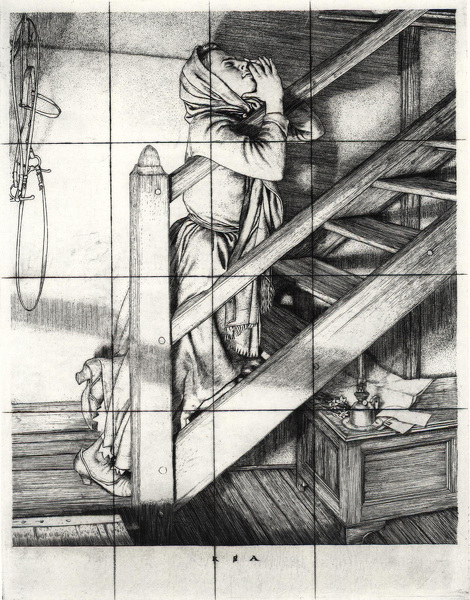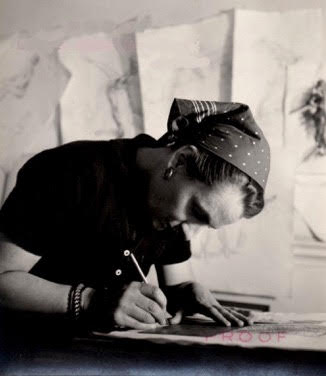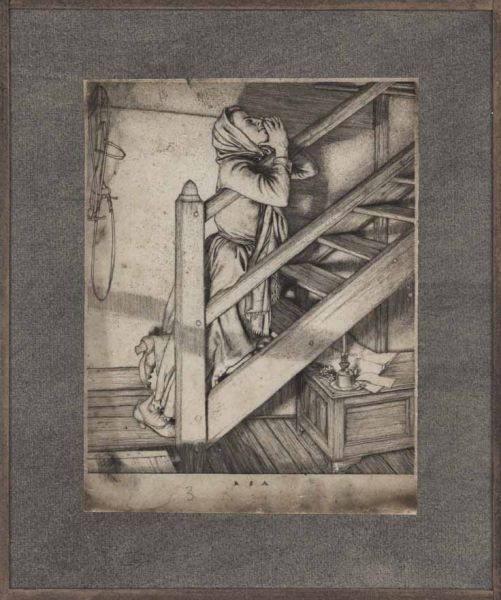

 Hover over the painting to magnify (there may be an initial delay while the magnified image is loaded)
Hover over the painting to magnify (there may be an initial delay while the magnified image is loaded)Free shipping
Robert Austin (1895-1973):
Evening, 1940
Unmounted (ref: 8366)
Engraving, signed in the plate
Print from cancelled plate
8.9 x 6.8 in. (22.5 x 17.2 cm)See all works by Robert Austin print houses interiors night scenes and sleep religion TOP 100 war women 1.Master Designs 1.master prints 1.PORTRAIT OF AN ARTIST
Provenance: The Artist's Family
Literature: Campbell Dodgson, Robert Austin, exh. cat.,Twenty-One Gallery, London, 1930; Gordon Cooke, Drawings and Prints by Robert Austin, exh. cat.,The Fine Art Society, London, 2001;Post Campbell Dodgson 130

photograph of Eleanor Hudson, circa 1940.
The stairs are those of the Methodist Chapel in Burnham Overy Staithe, Austin's home in Norfolk. Praying appeared as a motif in several of Austin's wartime prints - for instance Easter Sunday, 1940.

The Second World War virtually brought his printmaking to an end. Austin would take many months to complete a plate and the unsettling effect of the war forced not compromise but a halt to that activity. Besides, his teaching commitments with the RCA meant that he spent a lot of time travelling between London and the Lake District where the college had been evacuated. He made a few plates in the late 40's and early 50's but the wizening of his thumb prevented him from handling the burin effectively from 1951 onwards.
When he retired from the RCA professorship in 1955 Austin no longer had access to a press and he stopped making prints until 1963 when three magnificent but very late etching were made.
Peter Black, Robert Douwma Catalogue Twenty Nine, p 5
Austin's early plates show an extraordinary sweetness of line and often, as in his large plates of deer, beautifully unified compositions. There is in the best sense an academic quality about these, very proper in a man who was virtually a pioneer in his his art today. About 1929 a close study of the German masters of engraving is evident. But Austin has passed through his probationary stage and is master not only of his technique, in which no English engraver has surpassed him, but also in using his medium in a native, personal way. Already Mr Dodgson had noticed in his work 'an aftermath of Pre-Raphaelitism...with its harking back to the past and its wealth of realistic detail.'
Austin's latest plates are contemporary in subject. At the same time his interest in Millais, the Millais of book-illustrations, is explicit. Surely this strain, at once homely, intimate and romantic, is at the centre of the tradition of English art. Austin's line remains clear: his tone is given by a number of short flicks and shadings. He is thus nearer in technique to the fifteenth-century German engravers than to Durer or Lucas van Leyden. In drawing and composition there is nothing archaic. Of recent years he has produced three or four plates regularly each year. Of these one or two commonly represent new treatments of subjects previously treated in a rather different way. He is fascinated with certain subjects, bells, stairs, kneeling figures, weathered wood.But he also advances to new subjects; in 1936 two very fine portraits and in 1937 the Young Mother.
Extract from The English Print, Basil Gray, Adam and Charles Black 1937, on whose cover Austin's Young Mother featured:
 Rome Scholars
Rome Scholars




